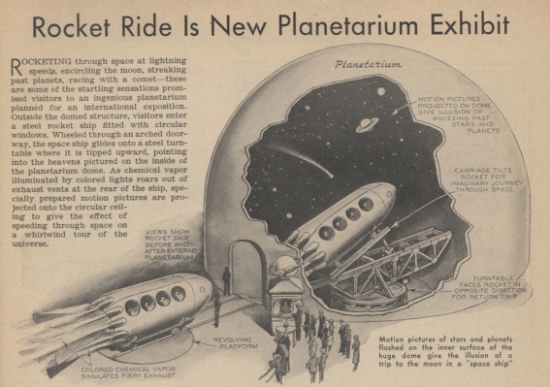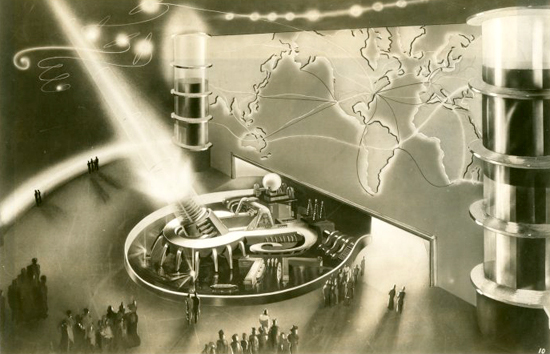Rocket to the Stars at the 1939 New York World’s Fair
A trip into space without leaving Earth—or even going outdoors
/https://tf-cmsv2-smithsonianmag-media.s3.amazonaws.com/filer/201204250400401938-april-popular-science-470x251.jpg)
At first glance, the cover of the April 1938 issue of Popular Science magazine looks like a particularly odd vision of the future. Is that a 1930′s rocketship, blasting off into space? What about the door on the right with a clearly marked “EXIT” sign above it?
Our Depression-era rocketship is indeed indoors and claims to be the design for a new planetarium exhibit that would show visitors the cosmos from the perspective of a soaring, futuristic spaceship.
Rocketing through space at lightning speeds, encircling the moon, streaking past planets, racing with a comet — these are some of the startling sensations promised visitors to an ingenious planetarium planned for an international exposition. Outside the domed structure, visitors enter a steel rocket ship fitted with circular windows.
The short article goes on to explain how the rocket would give the illusion of blasting off into space:
Wheeled through an arched doorway, the space ship glides into a steel turntable where it is tipped upward, pointing into the heavens pictured on the inside of the planetarium dome. As chemical vapor illuminated by colored lights roars out of exhaust vents at the rear of the ship, specially prepared motion pictures are projected onto the circular ceiling to give the effect of speeding through space on a whirlwind tour of the universe.

Illustration showing the proposed rocket ride inside of a planetarium
Though the “international exhibit” isn’t named, we can deduce that it was most likely for the 1939 New York World’s Fair the following year. Designed by Raymond Loewy, the exhibit wasn’t built precisely as Popular Science had described it. The final design still had a rocketship, but visitors were no longer seated inside of the vehicle. And rather than the stars, your new destination was London. Loewy’s design, depicting the spaceport mid-blast, is pictured below.

The 1939 New York World's Fair Focal Exhibit, as imagined by Raymond Loewy
Found inside the Chrysler Motors Building, this “Focal Exhibit,” gave visitors a presentation of the past, present and future of transportation. Though the Focal Exhibit is not as well remembered as GM’s Futurama exhibit, it certainly presented visitors with a wondrous vision of the future, emphasizing that “the world has steadily grown smaller, its people drawn ever closer together by improved methods of transportation on land and sea and in the air.”
From the Official Guidebook to the 1939 New York World’s Fair:
What of transportation in the “World of Tomorrow?” As the airplane finishes its flight across the screen, lines shoot out and harness the earth with other planets. Twinkling signal lights, the hum of gigantic motors and the warning sound of sirens indicate that the Rocketship is loading passenger for London. You see futuristic liners unloading at nearby docks; sleek trains glide to a stop, automobiles whisk voyagers to the spot, high-speed elevators rise and descend as the Rocketship is serviced for the coming journey. The moment of departure arrives. A great steel crane moves, a magnet picks up the Rocketship and deposits it into the breach of the rocketgun. A moment of awesome silence. A flash, a muffled explosion, and the ship vanishes into the night.
/https://tf-cmsv2-smithsonianmag-media.s3.amazonaws.com/accounts/headshot/matt-novak-240.jpg)
/https://tf-cmsv2-smithsonianmag-media.s3.amazonaws.com/accounts/headshot/matt-novak-240.jpg)